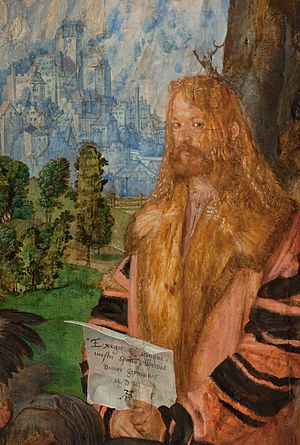Susannah Hornebolt facts for kids
Quick facts for kids
Susanna Hornebolt
|
|
|---|---|
| Born | 1503 |
| Died | c. 1554 (aged 50–51) England
|
| Nationality | Flanders (born) - England (1522 +) |
| Known for | Portrait miniature, illuminations |
|
Notable work
|
Illumination, The Savior |
| Spouse(s) | John Parker, John Gilman |
Susanna Hornebolt (born 1503, died around 1554) was a very important artist in England. She was the first known female artist to work in England during the time of the Tudor kings and queens.
Susanna learned to paint from her father, Gerard Hornebolt, who was also a famous artist from Flanders. Her brother, Lucas Horenbout, was also an artist. Susanna became well-known in Europe in 1521. This happened when the famous artist Albrecht Dürer bought one of her special illuminated paintings called The Savior.
Later, Susanna moved to England with her family. She became a lady-in-waiting (a helper) for several English queens. These included Jane Seymour, Anne of Cleves, and Catherine Parr. She might have also worked for Queen Mary I. People believe she was an artist for King Henry VIII and his royal court. Susanna married twice, first to John Parker and then to John Gilman.
Other famous artists like Albrecht Dürer, Guicciardini, and Vasari admired her artwork.
Contents
Susanna's Early Life and Art
Becoming an Artist in Ghent

Susanna Hornebolt was an illuminator. This means she created beautiful, detailed pictures and designs in books, often using gold and bright colors. She was the daughter of Gerard Hornebolt and Margaret Svanders. Susanna started working with her father around 1520.
By 1521, she was known across Europe for her miniature paintings and illuminations. That year, while she was in Antwerp with her father, the famous artist Albrecht Dürer bought one of her illuminated artworks. It was a painting of The Saviour.
Other important writers and artists also praised her work. Guicciardini wrote in 1567 that her skill in painting, especially miniatures and illuminations, was "beyond believing." Vasari wrote in 1568 that she was one of the few Flemish women who were excellent artists.
The Hornebolt family was part of the Ghent-Bruges school of manuscript illumination. King Henry VIII brought them to England. He wanted them to create small portrait paintings and religious illuminations. These artworks would show that God approved of the Tudor family ruling England.
Moving to England and Royal Service
Susanna came to England with her parents in 1522. She became a lady-in-waiting to Jane Seymour, who was one of King Henry VIII's wives. Susanna also worked as an artist for the King's court. Jane Seymour passed away in 1537.
Susanna's Marriages and Family Life
First Marriage to John Parker
Around 1525 or 1526, Susanna married John Parker. He worked for King Henry VIII as a Keeper of the Palace of Westminster and other important roles. The King even gave Susanna and John special gifts for New Year's in 1532 and 1533.
In 1534, the famous artist Hans Holbein the Younger painted small portraits of Susanna and John. These paintings might be the ones called A Court Official of King Henry VIII and his wife, which are now in a museum in Vienna. Susanna and John did not have any children. John Parker died in 1537. After losing both Jane Seymour and her husband, Susanna faced money problems.
Second Marriage to John Gilman

On September 22, 1539, Susanna married John Gilman in Westminster. He was a widower (meaning his first wife had died) and had a daughter. John Gilman worked for the King's Woodyard. Susanna was his second wife.
Just two weeks after her wedding, Susanna traveled to Cleves. She went there to help escort Anne of Cleves to England for her marriage to King Henry VIII. The King gave Susanna money to buy new clothes for this important trip. She was not rich at the time and needed proper clothes for the royal visit.
Susanna became a member of Queen Anne's special group of ladies. She was in charge of four servants. Queen Anne thought Susanna was the "first of her gentlewomen."
The Gilmans lived in London and later in Richmond. They had two sons and at least two daughters. Their first child, a son named Henry, was born around 1540. King Henry VIII was Henry Gilman's godfather. Susanna also had a daughter named Anne.
Susanna continued to serve in the household of Catherine Parr, another of Henry VIII's queens. She served until King Edward VI began his rule in 1547. Susanna might have also served Queen Mary I. Susanna died around 1554.
Susanna's Artistic Legacy
Susanna Hornebolt was known as a "clever illuminator" who worked for the King. Another female artist, Levina Teerlinc, also worked for the King and was a competitor. Many people believe that Susanna, her father Gerard, and her brother Lucas created portraits and miniatures of King Henry VIII.
The Society of Antiquaries of London said that Susanna "practised painting in miniature in England and with greatest success." She was very popular with King Henry VIII and everyone at the royal court. Authors Lorne Campbell and Susan Foister described her as an "excellent painter and illuminator." They said she was highly favored at King Henry VIII's court. Queen Catherine Parr was said to have hired three female miniature painters: Susanna Hornebolt, Levina Teerlinc, and Margaret Holsewyther.
Susanna in Stories
Susanna Horenbout and John Parker are the main characters in a series of historical fiction novels. These books were written by Michelle Diener and first published in 2011. In the stories, Susanna is shown as a skilled painter and a brave heroine.

